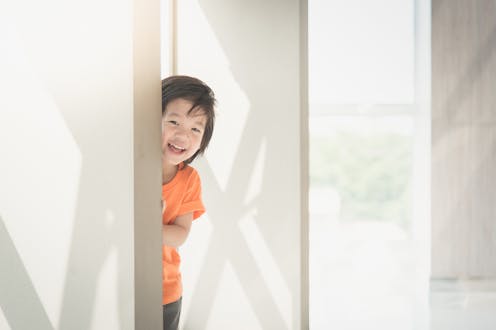Milestone developments at four years old help children tell lies, play hide-and-seek and read maps

At the age of about four, children reach important milestones in brain development.
One of these is a leap forward in understanding others’ thoughts and feelings. Another is in spatial thinking – understanding how objects are positioned and related.
New research with my colleague Catherine Sayer shows there is a leap at four years in particular spatial skills, indicating, for example, the beginnings of the ability to read maps.
We carried out a study with 175 two to five-year-olds to explore how children are able to use scale models to figure out where something is in the real world. At about four, children are able to use a scale model of a room to work out where something is. We thought that this might result from children’s understanding of how one thing can represent something else. But we actually found that four-year-olds’ ability to use scale models came from their spatial abilities.
At about four, children start to understand that someone’s behaviour depends on what that person believes, not necessarily what is really the case. This has interesting consequences.
If you’ve played hide-and-seek with young children, you may have noticed that they aren’t always very good at it. They love the ritual of looking in all the wrong places first, but beforehand they may tell you where they are going to hide, hide in the same place every time, or not be especially hidden.
Four-year-olds get much better at hide and seek. They understand that the seeker looks in the wrong places because they don’t know where the hider is. At about three to four children also start to tell lies. They realise they can make someone believe something that isn’t true.
Understanding symbols
My earlier research with fellow psychologist Josef Perner suggests that four-year-olds don’t just start to understand how others’ minds work. Figuring this out is part of the development of an understanding of “representation” – that symbols, like thoughts, words, or pictures, can be used to stand for something else.
Children start to think about how words relate to objects. This means, for instance, knowing that “animal” can refer to something you already have a name for, such as “rabbit”. This might help children learn the new word.
Children also realise that pictures can be interpreted in different ways. A classic example is the duck-rabbit ambiguous picture.

To a younger child, this picture only represents whichever thing they currently see. A four-year-old, though, can recognise that this picture shows two things.
A consequence of understanding how pictures “work” is an improved ability to do jigsaw puzzles. Watching a very young child complete a jigsaw, you may notice they use a lot of trial and error, picking up random pieces to see if they fit. By the time they are about four years old, they start to use the picture as a guide, trying to connect lines and bits of colour, and checking the guide picture on the box lid.
Developmental experiments
Another ability children develop at around four is using scale models. A classic set of developmental experiments involved a model of a regular household room. The real room had typical furniture – sofa, table, cupboard and so on – and the model had miniature versions laid out in the same way.
Children were shown where something was hidden in the model and told to find an object hidden in “the same place” in the room. Children of around four can find the object using the identical layouts.
Adults see scale models and maps as representations. Maps represent a town or a country. A scale model of, say, the Eiffel Tower represents the real thing.
We suspected children’s ability to use scale models is more evidence of understanding representation at this age.
We were wrong. Instead, we found that this ability is based on a development in children’s spatial abilities that also occurs at about four. This is the ability to think about spaces and where objects are within them. Spatial abilities help with maths skills, and good spatial ability is linked to an interest in science, technology, engineering and mathematics.
Read more: How spatial thinking could help children learn maths – and go on to use it in their careers
Our experiment was simple. We compared the model room task with a test of understanding how representation works. The two abilities develop around the same age, but we found they were not related. Children who could do one task couldn’t necessarily do the other.
We also had a test of purely spatial ability. Children who passed the model room task also passed the spatial task. So it looks like the model room task relied on children’s spatial thinking.
We don’t yet know why two important but apparently unrelated abilities arise at the same time. Perhaps it’s related to changes in the growing brain at this age.
What we did show is that four-year-olds can understand how one space relates to another. If shown a sticker under a particular chair in the model room, they can go straight to the “same” chair in the other room. This is the fundamental understanding required to read maps.
Martin Doherty receives funding from the British Academy.
